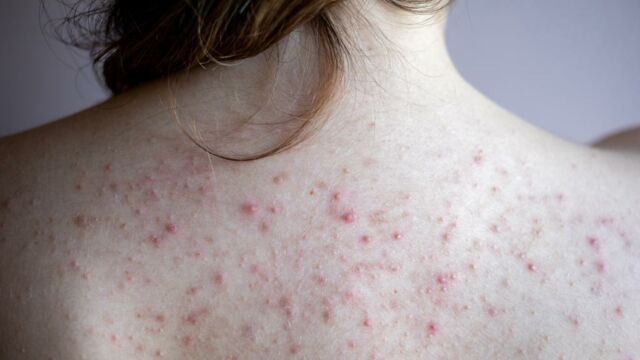Back acne, or bacne, can be easy to hide during the winter months, but when summer rolls around, and the tank tops come out, our spots are presented to the world.
Discover our latest podcast
When it comes to acne on our faces, there are a million and one products to help us, but what about acne on our backs? To know how to cure your bacne, you need to know what’s causing it.
What causes back acne?
Like facial acne, bacne is caused by an overproduction of sebum, a buildup of dead skin cells, bacteria and inflammation. When there is a buildup of sebum and skin cells in the pore, it creates the perfect environment for P.acnes bacteria to thrive, causing inflammation and acne.
Regular acne isn’t the only cause of bacne; fungal acne, which isn’t technically acne, can also cause breakouts on your back and shoulders. Fungal acne is caused by an infection of the skin cells, leading to inflamed breakouts on the face and body. These breakouts can often be itchy and present as clusters of tiny pimples.
How to get rid of back acne?
Wash your back with acne targeting cleansers
Washing your back regularly with a cleanser containing salicylic acid, benzoyl peroxide, or lactic acid can help to eliminate P.acnes bacteria, inflammation and treat bacne.
Use topical skincare products
Using moisturisers, toners, and spot treatments containing salicylic acid, benzoyl peroxide, lactic acid, and glycolic acid can also help shed dead skin cells and reduce acne-causing bacteria.
Use an exfoliating scrub twice a week
Using an exfoliating scrub twice a week can help to help shed dead skin cells and increase cell turnover. By eliminating these skin cells, they will have less opportunity to clog up pores and cause acne.
Wash your bras regularly
While many of us couldn’t even think to wear the same shirt two days in a row, a lot of people wear the same bra day in and day out. Washing your bras regularly ensures that acne-causing bacteria won’t build up on the straps and cause bacne.
Shower after the gym
P.acnes bacteria thrives in moist and warm environments, including your sweaty gym clothes. Ensuring you shower and change as soon as possible after a sweat session will prevent bacteria and bacne from getting out of control.
Wear breathable clothing
Just as your bras and gym clothing can become a supportive environment for acne-causing bacteria, wearing tight and synthetic materials can also lead to back acne. Instead, opt for looser and more breathable clothing will ensure your clothes don’t become a breeding ground for bacne.
Change your sheets and pillowcases regularly
Sheets and pillowcases often accumulate oils, dead skin cells, bacteria and residue from the air and not changing them often enough can often result in back acne. Instead, try to clean your sheets at least once every two weeks.
Don’t pick at your spots
No matter how ripe or irritating, your bacne is, you should never pick at your spots. Picking often breaks the skin and causes more inflammation, leading to worsening acne and infections.
Instead, be patient and let your back acne heal on its own.
Wash your hair regularly
If you have longer hair, your hair’s oils can disperse onto the back and shoulders, contributing to acne. Washing your hair once every two days will reduce the chances of back acne.
If your bacne isn’t responding to any treatments, then a dermatologist or a doctor may be able to prescribe some prescription creams or antibiotics.















